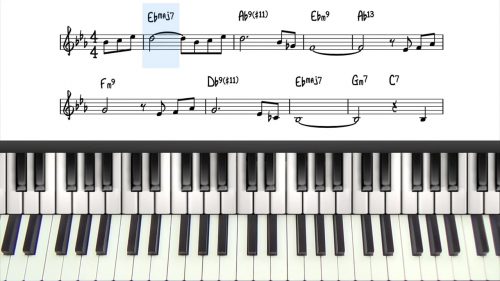The Nearness Of You Tutorial
The Nearness Of You is a jazz ballad written in the key of F Major. The tune follows an A1-A2-B-A1 form and there is also a 4 bar extension at the end which makes the tune 36 measures long.
We’re going to start with some simple two handed voicings and then create a more interesting arrangement by reharmonising the changes and adding in some upper structure triads, block chords and chord substitutions.
We also look at some interesting ways to reinforce the melody by mirroring the melody in both hands, similar to four way close style piano voicings.
Practice Tips
-
Another great tune for applying drop 2 voicings.
-
Look out for this kind of step wise melody in other jazz standards and then apply similar voicing techniques.
-
Don't forget about the unusual ending to this tune - the 4 bar extension at the end of the final A Section.





Excellent presentation and a beautiful arrangement hayden. Thank you so very much I highly enjoyed this and now i have go practice and implement such a wonderfull arrangement.
Thanks George, I’m glad you like the arrangement. I find it helps to think of the tune in terms of the form (AABA) … the A section repeats 3 times and so learning the A section will give you almost 75% of the chord changes. Remember to play through first with simple voicings (think 3rds and 7ths) and then add in extensions/alterations. Next tackle the B section separately and finally put it all together! Cheers, Hayden.
Really nice arrangement.👌 Thank you Hayden
Thanks for letting me know Ali.
Glad to hear you enjoyed the lesson.
If I can help you with anything you are working on just let me know.
Cheers! Hayden
Hayden, if you were to play this arrangement but have one pass through with a vocalist… what would you change? Would you drop all the melody notes entirely, or would you hit the occasional melody note, for example, keeping the top melody note on a chord change? Or, would you selectively play some melody notes here and there?
thx, Marcel
Hi Marcel,
Apologies for the late reply and good question here.
When playing with a vocalist it’s generally best to stay away from the melody because the melody is the singer’s role.
It’s very common for the singer to change the melody by adding notes in, taking note out, rephrasing it, etc… and so if you are playing the exact same note it can create a clash.
There is one exception, and that is if the singer is struggling to find the melody, or if he/she is a little off-pitch, then we can play the melody to guide the singer to the correct notes.
The other important things are:
Playing in the spaces – for example at the end of the A Section there is a lot of space when the singer holds the word “You” and so a good accompanist would be able to play in the spaces to add harmonic interest and perhaps melodic embellishments when the vocals take a break.
Keeping a solid rhythm – if it is just you and the singer, then it is your job to create a a solid rhythm and feel so it’s important to be able to ‘hear the pulse’ of the song with the voicings that you play.
My best piece of advice is to listen to lots of vocal/piano versions of this song, and try to work out the chords and accompaniment with your ears. If you are new to transcription check out the ear training section in the forum: https://www.pianogroove.com/community/c/improvisation-exercises/30
I hope this helps Marcel and let me know if you have any further questions.
Cheers, Hayden
Thoroughly enjoying this lesson.
Just lovely. Thank you!
Hi Hayden, could you please explain in the second A section, drop 2 voicing’s how you came up with the chords you used, A min. G min. F maj. and Eb maj.
Hi Mark,
Good question here.
Yes so we can create drop 2 voicings from rootless shapes. In this case the first chord A-7 could be viewed as 3-5-7-9 of F Major.
Another way of looking at this is that the chord for that entire bar is F major. If we think of the diatonic 7th chords in the key of F major, we would have Fmaj7 , G-7, A-7, etc… and notice the descending melody line which is the notes C, Bb, and A, is the 3rd of each of these 7th chords.(The I, ii, and iii, chords in F Major)
So really we are just harmonising the melody line with the diatonic 7th chords which happens to work well because the melody line is the 3rd of each chord, which isn’t really a coincidence, because melodies are often diatonic to the key of the tune, in this case F Major.
In short form summary, the melody is walking down the F Major scale, and so we can harmonise it with the diatonic 7th chords.
That brings us onto the Ebmaj7, if you swap the note D in your right hand to C, we then have the notes of C-7, which also sounds pretty cool.
The chord is C-7, and Ebmaj7 could be seen as 3-5-7-9 of C minor. Remember that the 3rd and 7th of a chord are the most important notes for defining the harmony, so whether we play C-7 rooted, or 3-5-7-9 (which is also Ebmaj7), both contain the 3 and 7 which is used as the ii-7 chord in the 251 moving to Bb Major in the following bar.
In short form summary, if you are ever puzzled with a chord being used, first think, could this be a rootless voicing, and often there is a some kind of relationship there.
I hope that helps Mark and please excuse my tardiness in getting back to you – it’s been a busy week!
Enjoy the lessons!
Cheers, Hayden